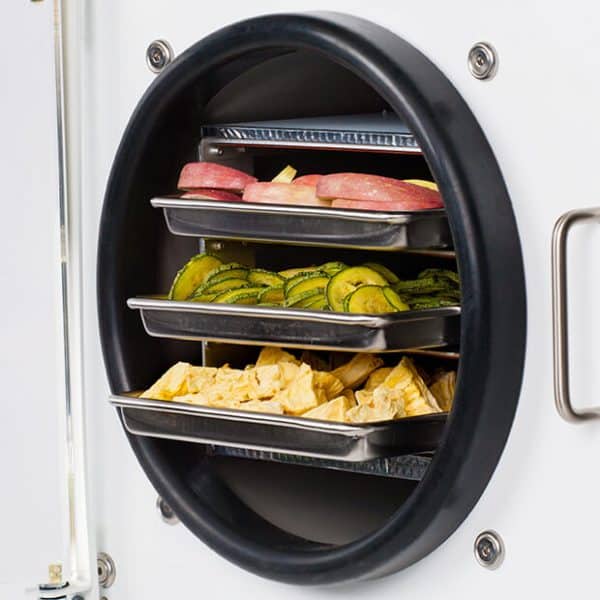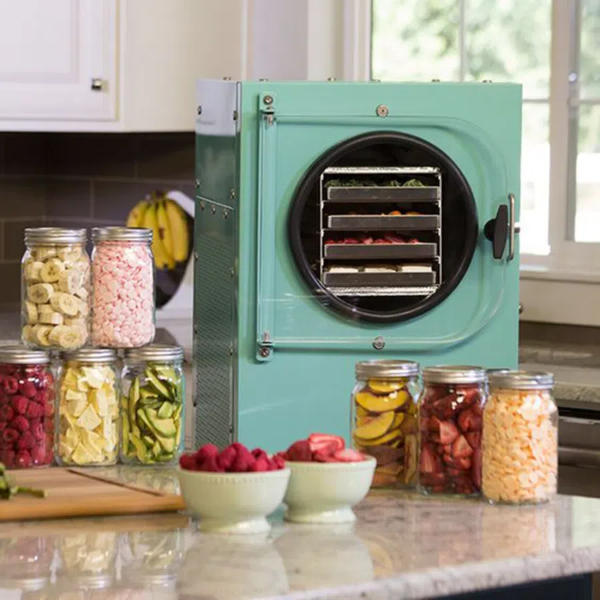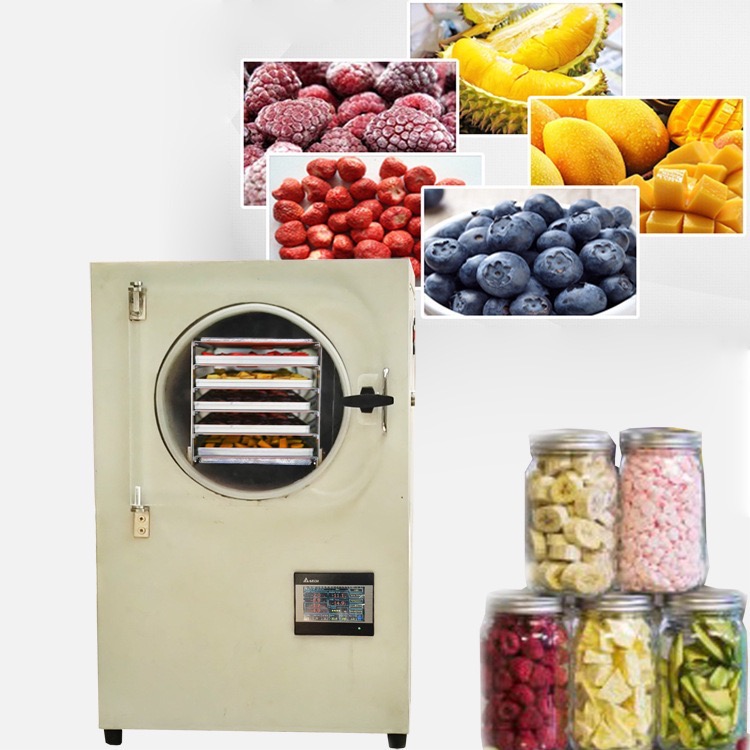
Content Menu
● Introduction to Home Freeze Drying
● What is a Freeze Drying Food Machine?
● The Benefits of Owning a Home Freeze Dryer
>> 1. Superior Food Preservation
>> 2. Long-Term Food Storage
>> 3. Versatility
>> 4. Cost-Effective in the Long Run
● How Does a Home Freeze Dryer Work?
● Choosing the Right Freeze Drying Food Machine for Home Use
>> Size and Capacity
>> Energy Efficiency
>> Ease of Use
>> Noise Level
>> Maintenance Requirements
● Popular Home Freeze Dryer Brands
>> Harvest Right Freeze Dryers
>> Other Brands
● DIY Freeze Drying: Is It Possible?
● Freeze Drying for Camping and Outdoor Adventures
● Freeze-Dried Fruits and Vegetables: A Healthy Snacking Revolution
● Emergency Food Preparation with a Home Freeze Dryer
● The Economics of Home Freeze Drying
● Maintenance and Care of Your Freeze Drying Food Machine
● Creative Uses for Your Home Freeze Dryer
● The Future of Home Food Preservation
● Conclusion
● Frequently Asked Questions
>> 1. How long does the freeze drying process take?
>> 2. Can I freeze dry liquids?
>> 3. How do I rehydrate freeze-dried food?
>> 4. Is freeze-dried food healthy?
>> 5. Can I freeze dry dairy products?
Introduction to Home Freeze Drying
In recent years, the concept of food preservation has taken a revolutionary turn with the introduction of home freeze dryers. These innovative appliances have transformed the way we think about long-term food storage and emergency preparedness. A home freeze dryer is not just a luxury item for food enthusiasts; it's becoming an essential tool for families looking to reduce food waste, preserve seasonal produce, and ensure a stable food supply in uncertain times.
What is a Freeze Drying Food Machine?
A freeze drying food machine, also known as a lyophilizer, is a sophisticated appliance that removes moisture from food through a process called sublimation. This process involves freezing the food and then creating a vacuum environment where the frozen water in the food transitions directly from a solid to a gas state, bypassing the liquid phase. The result is perfectly preserved food that maintains its original shape, color, and nutritional value.
The Benefits of Owning a Home Freeze Dryer
1. Superior Food Preservation
Unlike traditional food preservation methods such as canning or dehydrating, freeze drying retains up to 97% of the food's nutritional value. The process also preserves the original flavor, color, and texture of the food, making it an excellent choice for those who want to enjoy their favorite foods year-round.
2. Long-Term Food Storage
Freeze-dried foods can last for 25 years or more when properly stored, making them ideal for emergency food preparation and long-term food storage. This longevity is unmatched by any other preservation method, giving homeowners peace of mind knowing they have a reliable food source for years to come.
3. Versatility
A home freeze dryer can process a wide variety of foods, including:
- Fruits and vegetables
- Meats and fish
- Dairy products
- Complete meals
- Herbs and spices
- Pet foods
This versatility allows users to create a diverse and nutritious food storage plan tailored to their family's needs and preferences.
4. Cost-Effective in the Long Run
While the initial investment in a home freeze dryer may seem substantial, it can lead to significant savings over time. By preserving food at its peak freshness, you can take advantage of seasonal produce sales and bulk purchases, reducing overall food costs and minimizing waste.

How Does a Home Freeze Dryer Work?
Understanding the freeze drying process can help you appreciate the technology behind these remarkable machines. Here's a step-by-step breakdown of how a home freeze dryer operates:1. Freezing: The food is placed on trays and frozen to very low temperatures, typically around -40°F (-40°C).2. Vacuum Creation: Once frozen, the chamber is sealed, and a vacuum pump removes the air, creating a low-pressure environment.3. Sublimation: Heat is gently applied, causing the frozen water in the food to sublimate directly from ice to vapor.4. Condensation: The water vapor is collected on a cold condenser plate, turning it back into ice.5. Secondary Drying: A final drying phase removes any remaining moisture bound to the food's structure.6. Sealing: The dried food is then sealed in moisture-proof packaging to maintain its preserved state.
Choosing the Right Freeze Drying Food Machine for Home Use
When selecting a home freeze dryer, several factors should be considered:
Size and Capacity
Home freeze dryers come in various sizes, from small countertop models to larger units suitable for serious food preservation enthusiasts. Consider your space constraints and the volume of food you plan to process when choosing a size.
Energy Efficiency
Look for models with energy-efficient features, as freeze dryers can consume a significant amount of electricity during operation. Some newer models come with energy-saving modes and improved insulation to reduce power consumption.
Ease of Use
User-friendly interfaces and automated cycles can make the freeze drying process more accessible for beginners. Look for machines with clear controls and pre-set programs for different types of foods.
Noise Level
The vacuum pump in a freeze dryer can be noisy. If this is a concern, look for models with quieter operation or consider placing the unit in a garage or basement.
Maintenance Requirements
Regular maintenance is crucial for the longevity of your freeze dryer. Choose a model with easily accessible components and clear maintenance instructions.

Popular Home Freeze Dryer Brands
Harvest Right Freeze Dryers
Harvest Right is one of the leading manufacturers of home freeze dryers. They offer a range of sizes to suit different needs, from small units for individuals to large models for families or small businesses.
Other Brands
While Harvest Right dominates the home freeze dryer market, other brands are emerging with their own offerings. It's worth researching and comparing features and prices to find the best fit for your needs.
DIY Freeze Drying: Is It Possible?
For the adventurous and technically inclined, DIY freeze drying setups have gained popularity. However, it's important to note that these homemade solutions often lack the efficiency and safety features of commercial units. If you're considering a DIY approach, thoroughly research the process and understand the limitations and potential risks involved.
Freeze Drying for Camping and Outdoor Adventures
Freeze-dried foods are a game-changer for outdoor enthusiasts. Their lightweight nature and long shelf life make them ideal for backpacking, camping, and emergency kits. By freeze drying your own meals and snacks, you can ensure that you have nutritious, tasty food options no matter where your adventures take you.
Freeze-Dried Fruits and Vegetables: A Healthy Snacking Revolution
One of the most popular applications of home freeze dryers is creating healthy, shelf-stable snacks. Freeze-dried fruits and vegetables retain their natural sweetness and nutritional value, making them an excellent alternative to processed snacks. From crispy apple chips to tangy berry mixes, the possibilities are endless.
Emergency Food Preparation with a Home Freeze Dryer
In an era of increasing natural disasters and global uncertainties, having a reliable emergency food supply is more important than ever. A home freeze dryer allows you to create a customized emergency food stockpile that caters to your family's dietary needs and preferences. By freeze drying complete meals, you can ensure that you have nutritious, familiar foods available during challenging times.
The Economics of Home Freeze Drying
While the initial cost of a home freeze dryer can be significant, it's essential to consider the long-term economic benefits:
- Reduced food waste by preserving excess produce
- Ability to buy in bulk during sales and preserve for later use
- Creation of high-quality, preservative-free foods at a fraction of the cost of commercially freeze-dried products
- Potential for small business opportunities by selling freeze-dried goods
Maintenance and Care of Your Freeze Drying Food Machine
To ensure the longevity and optimal performance of your home freeze dryer, regular maintenance is crucial. This typically includes:
- Cleaning the chamber and trays after each use
- Regularly changing the vacuum pump oil
- Inspecting and replacing seals as needed
- Keeping the condenser free of ice buildup
Following the manufacturer's guidelines for maintenance will help you get the most out of your investment and ensure years of reliable operation.
Creative Uses for Your Home Freeze Dryer
Beyond basic food preservation, a home freeze dryer opens up a world of culinary creativity:
- Create your own instant meals for busy weeknights
- Preserve fresh herbs at their peak flavor
- Make lightweight, nutritious pet treats
- Develop unique textures for culinary experiments
- Preserve sentimental items like wedding bouquets
The Future of Home Food Preservation
As technology advances and more people become aware of the benefits of freeze drying, we can expect to see continued innovation in this field. Future home freeze dryers may feature:
- Smaller, more energy-efficient designs
- Integration with smart home systems for remote monitoring and control
- Advanced sensors for optimizing the drying process for different foods
- Improved user interfaces and automation features
Conclusion
A freeze drying food machine for home use represents a significant leap forward in food preservation technology. By offering unparalleled longevity, nutritional retention, and versatility, these appliances are changing the way we think about food storage and preparation. Whether you're a prepper, a health-conscious individual, or simply someone who loves good food, a home freeze dryer can be a valuable addition to your kitchen arsenal.
As we've explored in this comprehensive guide, the benefits of owning a home freeze dryer extend far beyond simple food storage. From creating emergency food supplies to unleashing culinary creativity, these machines offer a world of possibilities. While the initial investment may be substantial, the long-term benefits in terms of food quality, cost savings, and peace of mind make it a worthwhile consideration for many households.
As you embark on your freeze drying journey, remember that like any new skill, there's a learning curve involved. Don't be afraid to experiment with different foods and techniques to find what works best for you. With patience and practice, you'll soon be creating delicious, nutritious, and long-lasting foods that your family will enjoy for years to come.

Frequently Asked Questions
1. How long does the freeze drying process take?
The freeze drying process typically takes between 20 to 40 hours, depending on the type and quantity of food being processed. Fruits and vegetables generally dry faster than meats or complete meals.
2. Can I freeze dry liquids?
Yes, you can freeze dry liquids such as soups, broths, and even milk. However, it's important to pre-freeze these items before placing them in the freeze dryer to prevent spills and ensure even drying.
3. How do I rehydrate freeze-dried food?
To rehydrate freeze-dried food, simply add warm or hot water. The amount of water needed will depend on the food item, but generally, you'll want to use slightly less water than the original volume of the food. Let it sit for a few minutes, and the food will absorb the water and return to its original texture.
4. Is freeze-dried food healthy?
Yes, freeze-dried food is very healthy. The process retains up to 97% of the original nutritional value of the food, including vitamins, minerals, and antioxidants. Unlike other preservation methods, freeze drying doesn't require the addition of preservatives or chemicals.
5. Can I freeze dry dairy products?
Absolutely! Dairy products like cheese, yogurt, and even ice cream can be successfully freeze-dried. These items often create interesting textures and can be used in various culinary applications or eaten as unique snacks.












